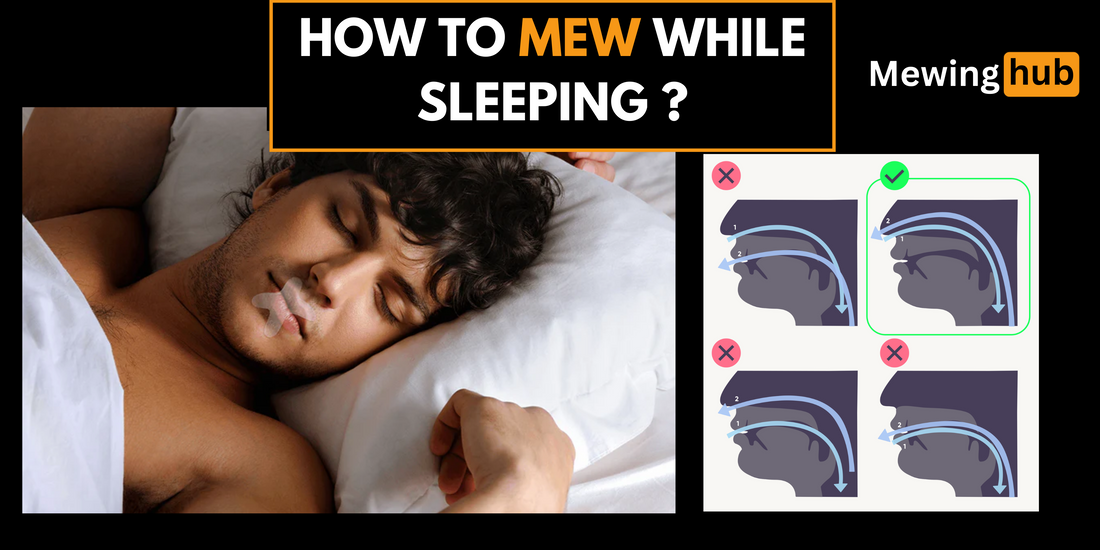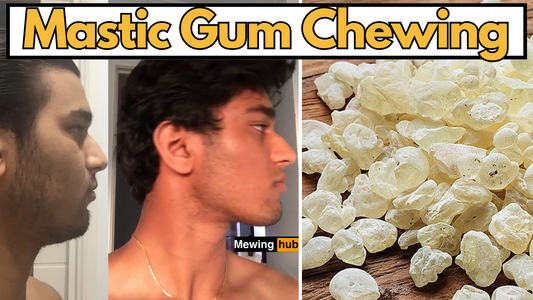How to Mew While Sleeping: Mastering Nighttime Tongue Posture

Share
Mewing, the practice of maintaining proper tongue posture, has gained popularity for its potential benefits in facial aesthetics and oral health.
While many focus on mewing during waking hours, learning how to mew while sleeping is crucial for maximizing results.
This comprehensive guide will explore techniques, tips, and tools to help you maintain proper tongue posture throughout the night.
Why Mewing While Sleeping Matters

Before diving into the how-to, let's understand why mewing while sleeping is important:
- Consistent practice: Nighttime mewing ensures 24/7 tongue posture maintenance
- Subconscious habit formation: Sleep mewing helps make proper tongue posture automatic
- Potential for accelerated results: Continuous mewing may lead to faster facial changes
Preparing for Nighttime Mewing
To successfully mew while sleeping, preparation is key:
- Master daytime mewing first
- Create a conducive sleep environment
- Address any breathing issues or sleep disorders
Mastering Daytime Mewing Technique
Before attempting to mew while sleeping, ensure you've perfected the technique during waking hours:
- Place the entire tongue against the roof of the mouth
- Keep lips closed and teeth lightly touching
- Breathe through your nose
How to Mew While Sleeping: Step-by-Step Guide
Follow these steps to maintain proper tongue posture throughout the night:

1. Pre-Sleep Mewing Exercises
Before bed, perform these exercises to reinforce proper tongue posture:
- Tongue chug: Push your tongue against the palate in a wave-like motion
- Suction hold: Create suction between your tongue and palate
2. Establish a Pre-Sleep Mewing Routine
Incorporate mewing into your bedtime routine:
- Practice conscious mewing for 5-10 minutes before sleep
- Focus on relaxing your jaw and facial muscles
3. Use Sleep Mewing Aids
Consider using tools to help maintain proper tongue posture:
- Mouth tape: Gently tape your lips to encourage nasal breathing and prevent mouth breathing
- Tongue positioners: Devices that help keep your tongue in the correct position
4. Optimize Your Sleep Position
Your sleep position can affect your ability to mew while sleeping:
- Back sleeping: Ideal for maintaining proper tongue posture
- Side sleeping: Can facilitate mewing by naturally encouraging the tongue to rest against the palate
5. Address Nighttime Breathing Issues
Ensure clear nasal passages for effective mewing while sleeping:
- Use a nasal dilator or strips if you have congestion
- Consider a humidifier to prevent dry mouth
The Role of Mouth Tape in Nighttime Mewing

Mouth tape is a valuable tool for those learning how to mew while sleeping:
- Encourages nasal breathing by gently keeping the lips closed
- Helps prevent mouth breathing, which can disrupt proper tongue posture
- Use hypoallergenic tape designed for skin to avoid irritation
When using mouth tape, start with short periods and gradually increase duration as you become comfortable.
Side Sleeping and Mewing
While back sleeping is often recommended, side sleeping can also facilitate mewing:
- Gravity naturally encourages the tongue to rest against the palate
- Use a supportive pillow to keep your head and neck aligned
- Experiment with different side positions to find what works best for you
Common Challenges in Mewing While Sleeping

Be aware of these potential obstacles:
- Mouth breathing habits
- Snoring or sleep apnea
- Teeth grinding (bruxism)
If you experience any of these issues, consult a healthcare professional for guidance.
Tracking Your Nighttime Mewing Progress
Monitor your progress to stay motivated:
- Keep a sleep mewing journal
- Take regular progress photos
- Note any changes in sleep quality or facial appearance
Tips for Consistent Nighttime Mewing
To make mewing while sleeping a habit:
- Be patient: It takes time to develop a new sleep habit
- Stay consistent: Practice every night, even if you don't maintain it all night initially
- Gradually increase duration: Start with short periods and work up to full nights
When to Seek Professional Help
If you're struggling with how to mew while sleeping, consider consulting:
- An orthodontist familiar with mewing techniques
- A sleep specialist if you have persistent breathing issues
Conclusion: Mastering the Art of Mewing While Sleeping
Learning how to mew while sleeping is a crucial step in maximizing the potential benefits of proper tongue posture. By following this guide, using tools like mouth tape, and understanding how side sleeping can facilitate mewing, you can work towards maintaining correct tongue position 24/7. Remember, everyone's journey is unique, so be patient with your progress and consult professionals when needed








